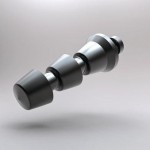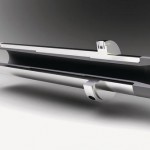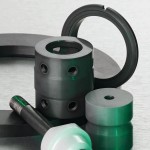A great number of criteria have to be considered when choosing the most suitable material. Apart from corrosion and abrasion strength, the total costs also play a major role. Special cemented carbides are often the best solution for components subject to heavy loads. Durit has developed a wide range of cemented carbide grades that vary according to technical requirements in terms of hardness and wear resistance or toughness and impact resistance.
The author: Heinz-Achim Kordt Design Manager, Durit Hartmetall
Even in times of economic upswing and full order books the demand for maximum efficiency and speedy throughput times in production to maintain competitiveness on the global markets remains a topical issue. Optimisation of production facilities and plant equipment is a major aspect in this context. The criteria are long service life, minimal downtime and low maintenance costs. When it comes to the selection of components, companies place more and more weight on highly resilient materials like cemented carbide.
Cemented carbide is a material made of tungsten carbide and a binder, usually cobalt. The binder plays a key role here: the more binder used in the mix, the greater the toughness of the material. A lower proportion of binder increases wear resistance. If corrosion resistance is a critical factor, cobalt is replaced by nickel or nickel-chrome. The grain size, on the other hand, determines material hardness or fracture toughness.
The exact material composition varies according to the application and the specific production conditions at the plant or in the machine on site. Durit has developed over 60 different types of cemented carbide at the company’s research institute located at its production site in Portugal. After all: only components custom-manufactured precisely down to the smallest detail will result in the targeted efficiency and cost advantages.
At the same time it is of paramount impor-tance to keep the total cost analysis in mind. In what stage of production is an exceptionally rugged material indispensable? When are components or parts made of other materials like cemented carbide better suited? And when is coating the components the best option for protecting them against wear?
Here are a few examples as practical illustrations. In the case of a hydrocyclone sepa-rator, the customer, a company in the petrochemical industry, decided on the following solution after joint consultation as well as careful consideration and analysis of all relevant factors. Because of the high flow speeds in the lower section of the hydrocyclone, the components are subject to extremely high loads during separation of the solids. This section has now been protected against wear through the use of cemented carbide. Another component of the same separator, the skimming valve, is now also made of cemented carbide. The so- lution chosen quickly proved to be the right one. The additional investment required for the use of cemented carbide paid off within a few months thanks to the significantly longer service life of the hydrocyclone.
Another application in chemical process engineering involved nozzles for injecting titanium dioxide (TiO2). The decision-makers opted to completely replace the existing steel nozzles with cemented carbide. In this way it was pos-sible to carry out the individual campaigns entirely without replacement of the nozzles. Here again the additional investment for the nozzles paid off quickly.
Another area of application for cemented carbide is valve technology. Due to the fact that more and more extreme materials have to be processed at chemical plants, the valve components usually used are exposed to increased wear. Replacing valve cones, valve seats, valve cages and plungers with components made of cemented carbide can effectively increase service life. This also applies to valve parts that wear due to cavitation. In this case special fine-grain grades are used. The structural characteristics of these cemented carbides prevent individual particles of the workpiece from detaching themselves during implosion of the steam bubbles and thus keep the component involved from undergoing premature wear.
The examples of applications from current practice underline the above mentioned importance of a meticulous analysis of the specific conditions on site. Experience shows that tailored products are in demand in over 90 % of the applications. A key criterion here is always the ratio between material costs and service life.
Thermal spraying
Production cycles of three months are wide-spread in the chemical industry. The job of maintenance is to keep the cycles as trouble-free as possible since every interruption generates costs. This includes continuous scrutiny of all components according to strict cost-benefit criteria. Complete replacement of components is not always the ideal solution. One alternative for protecting large and heavy parts against wear, for example, is thermal spraying. There are three different methods for this: high-ve-locity oxy-fuel flame spraying (HVOF), atmospheric plasma spraying (APS) and electric arc wire spraying (EAWS). The advantage: by means of these methods, carbides as well as ceramic and metallic materials can be joined to a substrate.
A classic example of a relevant application is pump technology where all components exposed to flowing liquids are usually subject to great loads and complete replacement of the products would involve high costs. In this case cemented carbide or ceramic coatings are suitable forms of wear protection. Special coatings for cemented carbide or HSS – such as thin-layer PVD (Physical Vapor Deposition) – enhance the performance of precision components. If a high degree of biocompatibility is required for special parts, they can be coated with a thin pure carbon or diamond layer.
Know-how from a single source
The development of innovative materials constantly opens up new vistas. It is therefore important to continuously further develop and expand the product range. Currently technical ceramics are on the rise. These materials combine hardness and good corrosion resistance with low density and above average temperature resistance. At the moment the focus of product development at Durit is on silicon nitride (Si3N4), a type of ceramic most similar to metal in terms of its characteristics. The very light material, in spite of its great hardness, proves itself particularly in the high-temperature range. It is thermoshock-resistant and features excellent fracture toughness.
Online-Info: www.cpp-net.com/0311432
Share:









